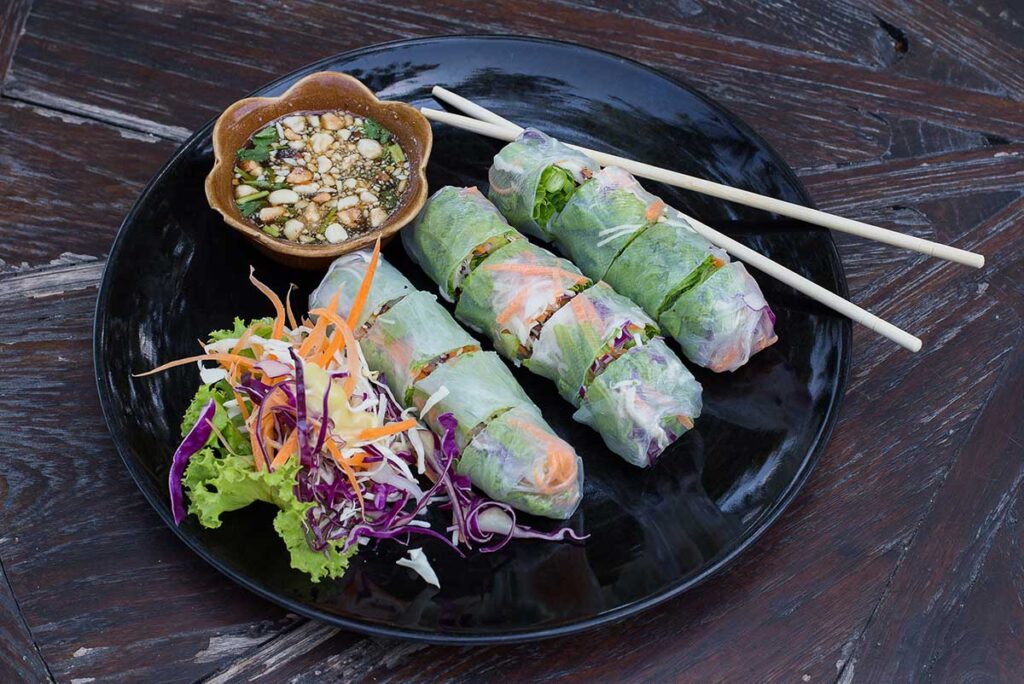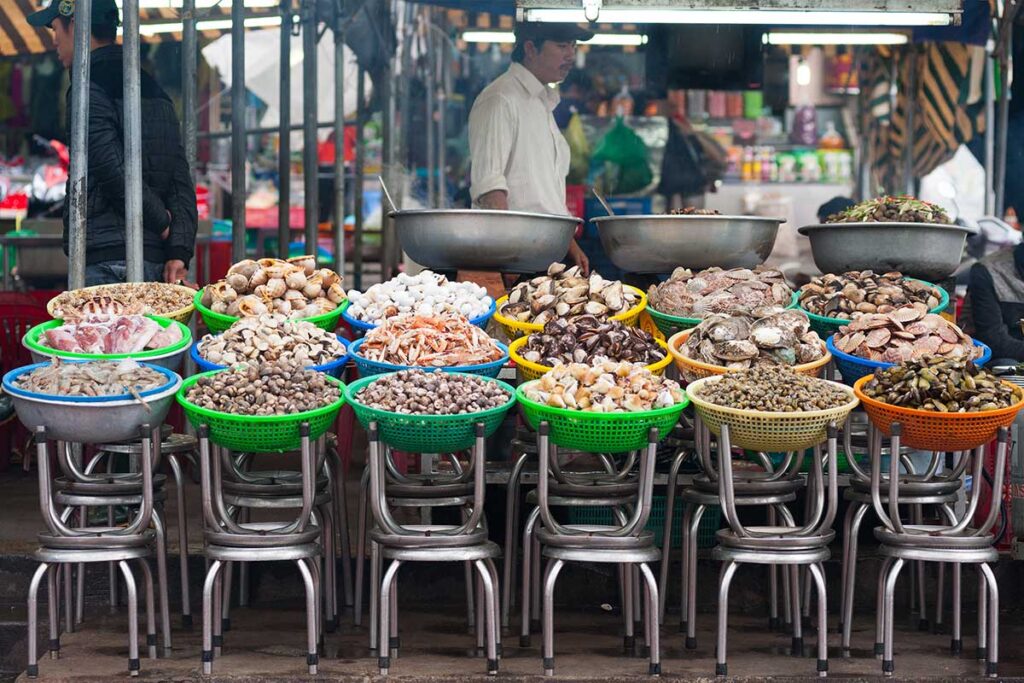Das Reisen mit Lebensmittelallergien in Vietnam kann eine Herausforderung sein, da in der lokalen Küche eine Vielzahl von Zutaten weit verbreitet ist. Doch mit sorgfältiger Planung und Vorbereitung kannst du die kulinarischen Köstlichkeiten des Landes sicher genießen, ohne deine Gesundheit zu gefährden. Hier sind 10 wichtige Tipps, um deine Lebensmittelallergien während deiner Vietnamreise erfolgreich zu managen.
Allgemeine Überlegungen für Reisen mit schweren Lebensmittelallergien in Vietnam
Vietnam ist ein fantastisches Reiseziel mit einer vielfältigen und köstlichen Küche, aber wenn du eine schwere Lebensmittelallergie hast, solltest du die möglichen Risiken genau abwägen. Besonders Erdnüsse, Schalentiere, Soja und Fisch können gefährlich sein. In manchen Teilen Vietnams fehlt es möglicherweise an Verständnis für die Schwere von Allergien, und Kreuzkontamination kann leicht passieren – vor allem bei Straßenständen oder in familiengeführten Restaurants.
Tipp: Wenn deine Allergie lebensbedrohlich ist und zu einem anaphylaktischen Schock führen kann, ist besondere Vorsicht geboten. Du solltest immer einen klaren Plan haben, dein Epipen (Adrenalin-Autoinjektor) jederzeit griffbereit halten und wissen, wo du im Notfall medizinische Hilfe bekommen kannst.
Für Menschen mit besonders schweren Allergien kann es ratsam sein, in bestimmten Gegenden auf den Verzehr von Speisen zu verzichten – besonders dort, wo die Kommunikation über Allergien schwierig ist. In solchen Fällen kann es sicherer sein, sich auf größere, touristenfreundliche Restaurants oder Unterkünfte zu konzentrieren, die eher auf spezielle Ernährungsbedürfnisse eingestellt sind.
Tipps für das Reisen mit Lebensmittelallergien in Vietnam
Mit ein wenig zusätzlicher Vorbereitung ist das Reisen mit Lebensmittelallergien in Vietnam durchaus möglich. Diese Tipps helfen dir, sicher durch die vielfältige kulinarische Landschaft des Landes zu navigieren und deine Reise sorgenfrei zu genießen.
1. Lass deine Allergien auf Vietnamesisch aufschreiben
Um deine Allergien effektiv zu kommunizieren, solltest du sie schriftlich auf Vietnamesisch dabeihaben. Trage eine Notiz mit dir, die deine Allergie in einfachen Worten erklärt. Zum Beispiel bedeutet „Tôi bị dị ứng với đậu phộng“ „Ich bin allergisch gegen Erdnüsse“. Diese schriftliche Notiz kann Restaurantmitarbeitern und Reiseveranstaltern helfen, deine Bedürfnisse schnell zu verstehen und Missverständnisse zu vermeiden.
2. Informiere Reiseveranstalter im Voraus
Wenn du Touren oder andere Erlebnisse buchst, die mit Essen zu tun haben, solltest du den Veranstalter im Voraus über deine Lebensmittelallergien informieren. So können sie notwendige Vorkehrungen treffen, etwa Mahlzeiten anpassen oder dich über potenzielle Allergene während der Aktivität informieren. Wenn du das frühzeitig erledigst, kannst du deine Reise entspannter genießen, ohne dir Sorgen über versteckte Allergene machen zu müssen.
3. Informiere dich über vietnamesische Gerichte
Bevor du nach Vietnam reist, ist es sinnvoll, sich mit typischen vietnamesischen Gerichten und ihren Zutaten vertraut zu machen. Viele Speisen, egal ob Straßenessen oder Restaurantgerichte, enthalten häufig Erdnüsse, Schalentiere, Soja oder Gluten. Wenn du weißt, welche Gerichte potenziell problematisch sein könnten, kannst du sichere Entscheidungen treffen und unnötige Risiken vermeiden, während du die vietnamesische Küche genießt.
4. Nimm deine eigenen Medikamente mit
Trage immer deine verschriebenen Allergiemedikamente bei dir, z. B. Antihistaminika oder einen Adrenalin-Autoinjektor (Epipen), und stelle sicher, dass du genug für die gesamte Reise dabeihast. Es ist wichtig, eine zusätzliche Menge mitzunehmen, falls es zu unerwarteten allergischen Reaktionen kommt. Außerdem solltest du deine Medikamente an einem leicht zugänglichen Ort aufbewahren, z. B. in deiner Tasche oder Hosentasche, damit du sie im Notfall schnell griffbereit hast.
5. Lerne wichtige vietnamesische Sätze
Ein paar wichtige Sätze auf Vietnamesisch zu kennen, kann dir helfen, deine Allergien besser zu kommunizieren. „Tôi bị dị ứng với…“ = „Ich bin allergisch gegen…“ „Tôi không thể ăn…“ = „Ich kann … nicht essen“ „Làm ơn không cho… vào món ăn của tôi“ = „Bitte fügen Sie … nicht zu meinem Essen hinzu“
Falls du kein Vietnamesisch sprichst, kannst du diese Sätze auf eine Notiz schreiben oder eine Sprach-App verwenden, um sie vorzulesen.
6. Verwende Allergie-Übersetzungskarten
Überlege, ob du Allergie-Übersetzungskarten nutzt, die du Restaurantmitarbeitern oder Reiseleitern zeigen kannst. Diese Karten sind besonders hilfreich in Gegenden, wo wenig Englisch gesprochen wird. Eine schriftliche Übersetzung stellt sicher, dass du deine Bedürfnisse klar kommunizieren kannst und reduziert das Risiko von Missverständnissen über deine Lebensmittelunverträglichkeiten.
7. Meide Street Food
Straßenessen ist ein großer Bestandteil der vietnamesischen Küche, kann aber für Menschen mit Lebensmittelallergien ein Risiko darstellen. Straßenverkäufer haben oft nicht die Möglichkeit oder das Wissen, um spezielle Allergieanforderungen zu berücksichtigen, und Kreuzkontamination ist eine häufige Gefahr. Es ist sicherer, in etablierten Restaurants zu essen, wo du deine Allergien besser erklären kannst und eher sicherstellen kannst, dass dein Essen ohne riskante Zutaten zubereitet wird.
8. Sei vorsichtig mit Saucen und Gewürzen
Viele vietnamesische Gerichte enthalten Saucen und Gewürze, die versteckte Allergene wie Soja, Fischsauce oder Erdnüsse enthalten können. Selbst wenn ein Gericht an sich sicher erscheint, solltest du immer nach den Zutaten in Saucen oder Dips fragen, die zum Essen serviert werden. Nước Mắm (Fischsauce) und Hoisin-Sauce können Allergene enthalten – frage nach, bevor du sie benutzt. Frage explizit, ob keine Erdnüsse, Soja oder Meeresfrüchte in den Saucen enthalten sind.
9. Packe sichere Snacks ein
Es ist immer eine gute Idee, eine eigene Auswahl an sicheren Snacks mitzunehmen – besonders wenn du in ländlichen Gegenden unterwegs bist oder die Essensauswahl eingeschränkt ist. Packe haltbare, allergiefreundliche Snacks ein, damit du etwas Sicheres zu essen hast, wenn du nichts Passendes findest. Besonders auf langen Busfahrten oder Trekkingtouren kann es praktisch sein, wenn du nicht sicher bist, ob die lokalen Gerichte für dich geeignet sind.
10. Wähle Restaurants mit Bedacht
Wenn du in Vietnam essen gehst, solltest du Restaurants wählen, die auf Touristen ausgerichtet sind oder englischsprachiges Personal haben. Diese Lokale sind oft vertrauter mit Lebensmittelallergien und können sicherere Optionen anbieten. Online-Bewertungen zu checken oder nach Empfehlungen zu fragen, kann helfen, Restaurants zu finden, die gut darauf vorbereitet sind, auf deine speziellen Ernährungsbedürfnisse einzugehen.
Mit einer Erdnussallergie in Vietnam reisen

Erdnussallergien erfordern in Vietnam besondere Vorsicht, da Erdnüsse manchmal als Garnitur oder Zutat in Gerichten verwendet werden. Während sie nicht immer sofort erkennbar sind, besteht das Risiko von Kreuzkontamination, besonders in Küchen, in denen regelmäßig mit Erdnüssen gekocht wird.
Tipp: Überprüfe immer doppelt mit dem Restaurantpersonal, ob ein Gericht Erdnüsse enthält – auch wenn sie nicht in der Speisekarte aufgeführt sind.
Vietnamesische Gerichte und Soßen, die Erdnüsse enthalten können:
- Mì Xào: Gebratene Nudeln
- Gỏi Cuốn: Frühlingsrollen (besonders mit Erdnusssauce)
- Bún Chả: Gegrilltes Schweinefleisch mit Reisnudeln (oft mit Erdnusssauce serviert)
- Phở: Rindernudelsuppe (manche Varianten enthalten Erdnüsse)
- Einige Dipsaucen: Hoisin-Sauce, Erdnusssauce
Wichtiger Hinweis: Auch wenn ein Gericht keine Erdnüsse enthält, kann es in einer Küche zubereitet worden sein, in der regelmäßig mit Erdnüssen gearbeitet wird. Informiere das Restaurantpersonal über deine Allergie und bitte darum, entsprechende Vorsichtsmaßnahmen zu treffen.
Mit einer Schalentierallergie in Vietnam reisen

Schalentierallergien sind relativ häufig, aber in Vietnam ist besondere Vorsicht geboten, da Meeresfrüchte eine zentrale Rolle in der Küche spielen. Besonders in Küstenregionen können Schalentiere in vielen Gerichten enthalten sein, und das Risiko von Kreuzkontamination ist hoch.
Tipp: Sei besonders vorsichtig, wenn du in Küstengebieten isst, wo Meeresfrüchte häufiger vorkommen. Frage immer nach den Zutaten, auch wenn ein Gericht auf den ersten Blick keine Schalentiere zu enthalten scheint.
Vietnamesische Gerichte und Soßen, die oft Schalentiere enthalten:
- Bún Riêu: Krabbennudelsuppe
- Mắm Tôm: Garnelenpaste
- Hải Sản: Allgemeine Bezeichnung für Meeresfrüchtegerichte
- Nước Mắm: Fischsauce (manche Varianten enthalten Schalentiere)
Wichtiger Hinweis: Manche Gerichte enthalten versteckte Schalentiere, zum Beispiel in Form von Garnelenpaste als Geschmacksverstärker. Frage immer beim Restaurantpersonal nach, um sicherzugehen.
Mit einer Glutenallergie in Vietnam reisen

Die vietnamesische Küche basiert oft auf Reis, was es für Reisende mit einer Glutenallergie einfacher macht, sichere Gerichte zu finden. Dennoch kann Gluten in bestimmten Speisen vorkommen, insbesondere in Nudeln, Saucen und einigen Brotsorten.
Tipp: Achte auf Gerichte mit Reisnudeln (Bún) oder Reispapier (Bánh Tráng), da diese von Natur aus glutenfrei sind.
Vietnamesische Gerichte und Soßen, die Gluten enthalten können:
- Xôi: Klebreis (manche Varianten enthalten Sojasauce, die Gluten enthält)
- Bánh Mì: Vietnamesisches Baguette-Sandwich (das Brot enthält Gluten)
- Mì: Weizennudeln (enthalten Gluten)
- Einige Dipsaucen: Sojasauce, Hoisin-Sauce (kann Gluten enthalten)
Wichtiger Hinweis: Manche Gerichte werden mit Utensilien oder in Pfannen zubereitet, die auch für glutenhaltige Speisen genutzt wurden. Informiere das Restaurantpersonal über deine Allergie und bitte darum, Vorsichtsmaßnahmen gegen Kreuzkontamination zu treffen.
Mit einer Milchallergie in Vietnam reisen
Milchprodukte sind in Vietnam nicht so weit verbreitet wie in westlichen Ländern, kommen aber dennoch in einigen Gerichten und Getränken vor, insbesondere in Desserts und Kaffee. Daher ist es wichtig, vorsichtig zu sein – vor allem bei süßen Speisen und vietnamesischem Kaffee.
Tipp: Sei dir bewusst, dass manche vietnamesische Desserts und Kaffeegetränke Kondensmilch enthalten.
Vietnamesische Gerichte und Soßen, die Milchprodukte enthalten können:
- Cà Phê Sữa: Vietnamesischer Kaffee mit Kondensmilch
- Bánh Flan: Vietnamesisches Crème Caramel
- Sữa Chua: Joghurt (oft aus Kuhmilch hergestellt)
Wichtiger Hinweis: Obwohl Milchallergien in Vietnam weniger verbreitet sind, solltest du das Restaurantpersonal trotzdem über deine Allergie informieren, um mögliche Probleme zu vermeiden.
Mit einer Fischallergie in Vietnam reisen
Fischsauce ist ein Grundbestandteil der vietnamesischen Küche und kann in vielen Gerichten vorkommen – auch in solchen, die auf den ersten Blick fischfrei erscheinen. Diese fermentierte Würzsauce aus Anchovis wird in Suppen, Salaten und sogar als Marinade für Fleisch und Gemüse verwendet.
Spezifischer Tipp: Wenn du auswärts isst, informiere das Restaurantpersonal unbedingt über deine Fischallergie und frage nach, ob Fischsauce in den Gerichten verwendet wird – auch wenn Fisch nicht ausdrücklich als Zutat aufgeführt ist. Bitte um alternative Würzmittel oder Gerichte, die ohne Fischsauce zubereitet werden können.
Vietnamesische Gerichte, die oft Fischsauce enthalten:
- Fast alle Dipsaucen: Nước Chấm (die allgegenwärtige Dipsauce) enthält oft Fischsauce.
- Marinaden für gegrilltes Fleisch und Gemüse: Fischsauce ist eine häufige Zutat in Marinaden.
- Gebratene Gerichte: In vielen Pfannengerichten wird Fischsauce als Gewürz verwendet.
- Nudelsuppen: Manche Brühen basieren auf Fischsauce.
- Salate: Einige vietnamesische Salate enthalten Fischsauce in der Dressing-Basis.
Mit einer Sojaallergie in Vietnam reisen
Soja ist eine häufige Zutat in vielen vietnamesischen Gerichten, insbesondere in Form von Sojasauce. Sie wird in Pfannengerichten, Dipsaucen und sogar in einigen Suppen verwendet. Deshalb ist es wichtig, immer nachzufragen, ob Soja in einem Gericht enthalten ist.
Spezifischer Tipp: Da Sojasauce eine gängige Zutat in der vietnamesischen Küche ist, solltest du das Restaurantpersonal immer über deine Sojaallergie informieren und nachfragen, ob sie in einem Gericht enthalten ist – auch wenn sie nicht ausdrücklich auf der Speisekarte steht. Bitte darum, Gerichte ohne Sojasauce oder mit alternativen Gewürzen zuzubereiten. Beachte, dass Fischsauce (Nước Mắm) manchmal zusammen mit Sojasauce verwendet wird, also frage am besten nach beiden.
Vietnamesische Gerichte und Soßen, die Soja enthalten können:
- Tương: Eine fermentierte Sojabohnenpaste, die als Würzmittel verwendet wird.
- Mì Xào: Gebratene Nudeln (können Sojasauce enthalten).
- Bún Chả: Gegrilltes Schweinefleisch mit Reisnudeln (oft mit einer Sojasaucen-basierten Dipsauce serviert).
- Phở: Rindernudelsuppe (manche Varianten enthalten Sojasauce).
- Gỏi Cuốn: Frühlingsrollen (können Sojasauce in der Füllung oder in der Dipsauce enthalten).